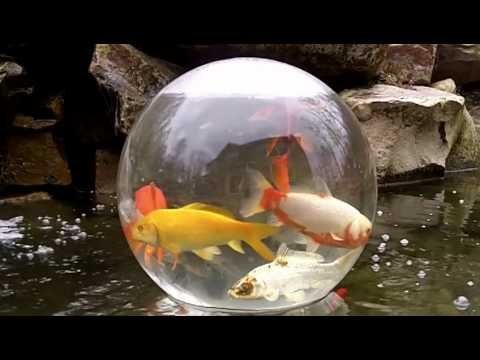Future Pets' Pond Manual
Feeding Your Pond Fish to Keep Them Healthy
Ornamental Fish Have No Stomach
Neither Goldfish nor Koi have true stomachs in our sense of the word. They have no "acid bath" reservoir (like our stomachs have) where large pieces of food can be held and digested. Instead, they have long, folded, alkaline intestinal tracts where enzymes digest food matter all along the winding intestinal path. In other words, as with their ingestion mechanisms, the digestive tracts of Koi and Goldfish are designed for fairly continuous processing of small amounts of diverse food types. One meal a day is not an adequate schedule.
Carbohydrates are not as important to goldfish as they are to humans. They get most of their energy for activity from fats and nutirtion for growth from proteins.
Seasons Dictate the Type and Amount of Food Your Fish Need
 Keeping healthy fish in your pond is relatively straightforward, if you
pay attention to proper nutrition and water quality. In a natural setting,
pond fish have a varied diet, based upon the season. The seasons are
determined by temperature, and so is the type of food your fish should receive.
Keeping healthy fish in your pond is relatively straightforward, if you
pay attention to proper nutrition and water quality. In a natural setting,
pond fish have a varied diet, based upon the season. The seasons are
determined by temperature, and so is the type of food your fish should receive.
Pond fish are most active during the summer months when the temperature is over 70°. It is at this time that you should feed the largest volume and highest protein pond foods.
Spring and Autumn call for lighter feeding with a lower protein diet.
As the temperature begins to fall to 60°, their metabolism is slowing and their immune system is not as sharp. You might want to switch to an easier-to-digest formula with lower protein or a wheat germ formula. During the winter (below 45° F), it is not necessary - in fact not advisable - to feed the fish at all.
Young Fish Need Higher Protein
Young fish should be fed a high protein, growth formula that provides more building blocks for amino acids. The higher levels of proteins and the extra energy afforded by these "hotter" ingredients are very important for rapidly growing or spawning fish.
Enhance Their Color with Karotin - The same amino acid protein that makes Carrots Orange
If you wish to enhance the color of your fish, feeding a color enhancing diet is in order. Most color enhancing diets use Karotin or krill to liven the reds and yellows in your fish. Most color foods should be fed for only a few weeks. Then return to your regular maintenance diet.
To get the most enjoyment from your fish, feed small amounts when your are able to enjoy the scurrying for food.
Vacationing does not have to present a problem as pond feeder blocks can be dropped into the water to feed the fish in your absence, or automatic fish feeders can be installed.
| Water Temperature | Feeding Schedule |
| 45 degrees & Below | Do not feed |
| 45 - 60 degrees | Feed once or twice a week |
| 60 - 65 degrees | Feed two or three times a week |
| 65 - 75 degrees | Feed once or twice a day |
| 75 - 85 degrees | Feed twice a day |
| 85 degrees and above | Do not feed |
View Our Fish Feeding Product Offerings